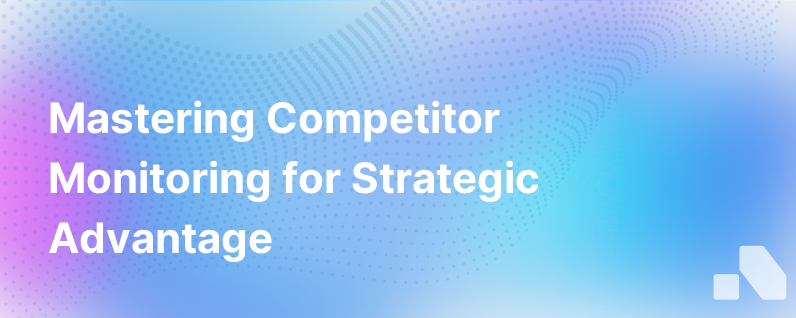
Competitor monitoring is a key activity for any business aiming to maintain a competitive edge. In a fast-paced digital world, your rivals are constantly evolving to meet changing market demands, launching novel products, adjusting their pricing models, and implementing new marketing strategies. By monitoring your competition, you can anticipate changes and adapt your business strategies.
In this article, we will explore why competitor monitoring is so crucial in today's competitive landscape, how to effectively track competitive activities, and discuss tools you might leverage to stay ahead of the game.
Benefits of Competitor Monitoring
In the business world, eyes and ears are indispensable assets. The more you know about what's happening around you, the more equipped you are to navigate the labyrinth of competition. Here are a few ways competitor monitoring can provide significant value to your company:
Inform Strategic Decisions: Competitor monitoring can guide your overall business strategy, from products and pricing to marketing and sales efforts. Being aware of competitor moves will enable your company to pre-emptively tweak strategies to stay ahead.
Discover Industry Trends: By tracking multiple competitors, you can identify industry patterns and trends, enhancing your company's capacity to innovate and stay relevant.
Derive Sales Intelligence: Insights about competitor offerings can provide your sales team with powerful tools to position your own products or services more effectively, aiding in prospecting and account retention.
Identify Market Opportunities: Competitor monitoring can unveil gaps in the market, offering opportunities to introduce new products or modify existing ones.
Effective Competitor Monitoring Strategies
Competitor monitoring involves a multichannel approach to gather and analyse information about your competitors. Here are some effective strategies for a thorough competitor surveillance structure:
Website Monitoring: Competitor websites are a treasure trove of information. You can identify new products, changes to product features, pricing shifts and promotional offers. Also, exploring their customer testimonials and case studies can provide insight into their customer relationships and areas that resonate with their audience.
Social Media Monitoring: The digital age has made it easier to track your competitor's online activities. Pay attention to their content on different social platforms to understand their marketing tactics or product updates. Tools like Brandwatch and Hootsuite make social media monitoring significantly simpler.
Sign Up For Newsletters: Want an insider's view on competitor initiatives? Subscribe to their newsletters. This can provide valuable information about product updates, promotions, white papers, webinars, or other pertinent details.
Attend Industry Events and Webinars: Trade shows, conferences, and webinars offer opportunities to understand your competitor's vision and strategy. You might gain insight from an expert's perspective or even have a chance to interact with their representatives.
Set Up Google Alerts: This method allows you to receive news related to your competitors directly in your inbox. Set up Google alerts for competitors' brand names and key products.
When monitoring competitors, take note of who their customers are, their customer retention strategies, lasting partnerships, their unique selling points, and what makes their products or services unique.
Leveraging Competitor Monitoring Tools
There are a host of tools in the marketplace that can automate competitor monitoring, providing real-time insights. Tools like Crayon and Kompyte offer competitive analysis in an easy-to-understand format. For SEO monitoring, platforms such as SEMRush and Ahrefs can offer a comprehensive understanding of competitor's SEO strategies.
However, one of the most powerful tools in the B2B sales landscape is an AI platform like Aomni. Aomni centralizes account information, compiles insights about your competitors, and auto-generates battle cards, ensuring your sales team is supplied with up-to-date information in real-time.
Lessons Learned: Making Smart Use of Your Insights
The real value of competitor monitoring is not just in the accumulation of information, but in the analysis and application of that data. This intelligence should influence everything from product pricing to sales pitches and customer support. In comparing your strengths and weaknesses against your competitors, you form not just a defensive shield, but also a strategic foundation for offensive growth tactics.
Conclusion
In a rapidly altering business landscape, the only way to stay ahead is to keep informed. Competitor monitoring offers valuable insights that can fuel strategic decision-making, helping your company maintain a robust competitive edge. It's up to you to transform raw data into actionable intelligence, fostering a proactive business culture in the face of competition. Leverage the power of AI platforms like Aomni to stay one step ahead, delivering the most strategically informed sales in real time.